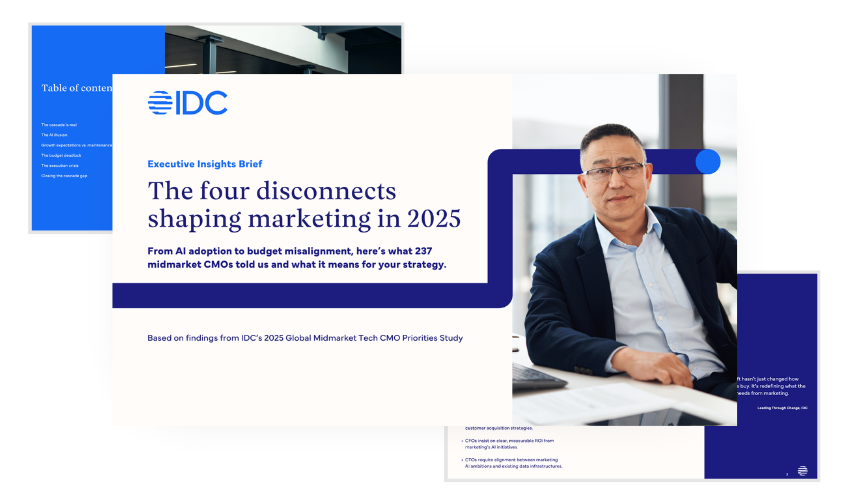Today’s marketing leaders are being asked to drive bold innovation, lead AI-powered transformation, and deliver measurable revenue gains – all on last year’s budget.
This might sound like a familiar challenge for many midmarket tech CMOs. Expectations have grown more strategic, yet financial support remains static.
Fifty-four percent of midmarket CMOs expect no increase in their marketing budgets, according to IDC’s 2025 Global Midmarket Tech CMO Priorities Study. But the pressure to demonstrate marketing’s impact on growth, acquisition, and customer experience remains.
This misalignment is more than a budgeting deadlock. It reflects a widening disconnect between executive demands and what resources marketing teams have to deliver.
In a landscape increasingly shaped by AI adoption, customer expectations, and competitive urgency, this gap is a structural barrier. And it is one that threatens marketing leaders’ ability to innovate, differentiate, and scale.
This is just one of four critical disconnects IDC has identified within marketing teams today. Left unaddressed, the misalignment between corporate visions and budgeting reality doesn’t just slow down marketing. It stalls enterprise growth.

To learn more, download IDC’s Executive Insights Brief: The four disconnects shaping Marketing in 2025 for three data-backed strategies to break the budgeting deadlock between marketing and the C-suite – plus more insights into the strategic challenges facing CMOs today.
Budgets are buried in the pressure cascade
Today’s CMOs are navigating what IDC defines as the Pressure Cascade: a convergence of executive-level demands that place marketing at the center of enterprise transformation. Marketing leaders are now tasked with more than demand generation or pipeline contribution. They must also:
- Drive innovation to acquire new customers and power growth.
- Deploy AI programs to personalize and enhance the customer experience – with measurable results.
- Deliver a coherent marketing strategy that aligns with existing data infrastructures.
These expectations reflect a clear shift in the CMO’s role in the organization. Yet the financial structure supporting this evolution remains stuck in the past. Budgets are still planned around yesterday’s definitions of marketing – not today’s enhanced, cross-functional transformation.
Why budgets aren’t budging
The data uncovered by IDC reveals the disconnect leading to the budget plateau. Thirty-two percent of marketing leaders believe the C-suite will prioritize cost optimization and ROI in the next 12-18 months.
Still, more than a third of CMOs are challenged to justify investments in brand marketing and awareness, while nearly a quarter struggle with measuring and proving the strategic value of marketing.
The difficulty of proving marketing’s worth within the organization is compounded by rising economic uncertainty, and complex executive demands limits CMOs’ ability to deliver on expectations. In an era when money is being directed towards tech modernization and AI initiatives, marketing can be left off the table.
Without budget flexibility or the data to frame marketing as a growth engine, leaders risk being constrained by outdated assumptions, even as the demands of the business move forward.
The strategic cost of standing still
Static or minimally adjusted budgets may seem manageable for now, but they create long-term strategic risk for the entire organization. When funding doesn’t keep pace with the expanding scope of marketing’s purview, critical initiatives can be delayed, scaled back, or abandoned entirely.
IDC research shows midmarket CMOs are under mounting pressure to develop areas that directly influence revenue and customer acquisition, such as AI-enhanced experiences, advanced personalization, and predictive analytics.
Without adequate resources, these high-impact opportunities are left underfunded. The result is a widening gap between organizations that execute bold strategies and those that are stuck in the past – losing revenue potential, market visibility, and the path to modernization.
When “making do” doesn’t do enough
In the absence of significant budget increases, many CMOs are doing their best to optimize what they have. IDC’s 2025 study shows the top two marketing priorities for the next 6-12 months are increasing revenue from existing customers (34%) and reducing costs or streamlining operations (31%).
While these are important goals, they take the focus away from the big-picture initiatives that drive new customer acquisition or enable advanced AI adoption. These adjustments can free up resources in the short term, but they don’t have the capacity to enable market-shaping campaigns.
Legacy systems, underfunded teams, and outdated, siloed technology make it difficult to deliver the personalization, speed, and insight modern buyers expect. Without meaningful reallocation toward initiatives that directly align with executive priorities, minor budget tweaks risk becoming an exercise in standing still – not moving forward.
What’s at stake: Agility, credibility, and the competitive edge
Failing to address the budget deadlock has consequences that go beyond marketing’s internal performance metrics. Without the resources to pivot, CMOs cannot respond quickly to market shifts or capitalize on emerging opportunities.
A lack of agility can erode marketing’s perceived value across the organization. Thirty-four percent of marketing leaders said demonstrating marketing’s strategic impact and ROI was their biggest challenge in establishing internal credibility and trust. Similarly, 26% said they faced difficulty proving marketing’s leadership role in driving business growth.
Without a larger budget to meet expanded expectations, teams are forced to spread limited resources across too many priorities. Results become harder to measure and even more difficult to defend. Over time, this fuels the perception that marketing is a cost center rather than a revenue driver.
Externally, the competitive risks are just as significant. Organizations that devote resources now to AI-enabled engagement, targeted acquisition, and data-driven personalization are setting themselves up for future success.
Those that delay investment risk falling into a reactive role – chasing market leaders instead of setting the pace. For midmarket CMOs, the ability to secure and strategically deploy a sizeable budget is tied directly to their ability to lead the competition.
Breaking the deadline: The path forward is strategic, not reactive
Flat budgets are more than just a financial plateau. Over time, they reduce marketing’s ability to deliver on executive priorities, limit the scope of innovation, and dull the organization’s competitive edge. In an environment where AI adoption, customer demands, and market shifts are accelerating, standing still is not an option.
CMOs who move beyond reactive, incremental thinking and approach budget planning as a strategic exercise are better positioned to meet heightened executive expectations. They have clear, data-backed business cases, resources aligned with company-wide priorities, and measure impact in terms of enterprise growth.
The budget deadlock is real, but so is the opportunity. With the right data, a disciplined approach to resource allocation, and a willingness to reframe budget conversations, marketing can reclaim its role as a growth engine, not a cost center.
The path forward isn’t asking for more. It’s about making every dollar work harder toward measurable, high-impact outcomes.
Break free from your budget deadlock. Access IDC’s Executive Insights Brief: The four disconnects shaping Marketing in 2025 for data-backed strategies to realign your marketing budget for growth – and more insights into the top challenges facing today’s CMOs.




